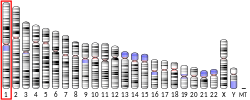Search results
Appearance
There is a page named "Enhanceosome" on Wikipedia
- An enhanceosome is a protein complex that assembles at an enhancer region on DNA and helps to regulate the expression of a target gene. Enhancers are bound...5 KB (558 words) - 23:21, 23 May 2025
- coactivators, assembling into a large structure known as an enhanceosome. The composition of the enhanceosome depends on ambient factors within the cell, particularly...49 KB (6,227 words) - 17:23, 29 April 2025
- TJ, Bienz M (March 2017). "Constitutive scaffolding of multiple Wnt enhanceosome components by Legless/BCL9". eLife. 6: e20882. doi:10.7554/elife.20882...64 KB (7,432 words) - 20:39, 20 May 2025
- (UCE) and core element of the rDNA promoter, bending the DNA to form an enhanceosome. SL1 has been found to stabilize the binding of UBTF to the rDNA promoter...11 KB (1,210 words) - 06:00, 28 October 2024
- Henriksen MA, Zhang X, Darnell JE (October 2003). "STAT3-dependent enhanceosome assembly and disassembly: synergy with GR for full transcriptional increase...37 KB (4,047 words) - 22:45, 4 June 2025
- Henriksen MA, Zhang X, Darnell JE (October 2003). "STAT3-dependent enhanceosome assembly and disassembly: synergy with GR for full transcriptional increase...29 KB (3,485 words) - 06:51, 2 June 2025
- Library of Medicine Medical Subject Headings (MeSH) NURSA C39 NURSA C54 p300-CBP regulatory mechanism in the IFN-β enhanceosome complex Portal: Biology...18 KB (2,107 words) - 07:43, 4 May 2024
- different theories on the information processing that occurs on enhancers: Enhanceosomes – rely on highly cooperative, coordinated action and can be disabled...53 KB (6,035 words) - 02:48, 17 March 2025
- cooperative action of several transcription factors (which constitute enhanceosomes). Remote enhancers allow transcription regulation at a distance. Insulators...49 KB (5,867 words) - 10:43, 1 February 2025
- cooperative and coordinated cis-regulatory modules are classified as enhanceosomes. The architecture and the arrangement of the transcription factor binding...30 KB (3,469 words) - 01:44, 6 July 2025
- vivo recruitment to the major histocompatibility complex (MHC) class II enhanceosome, and MHC class II gene transactivation". Molecular and Cellular Biology...9 KB (1,239 words) - 04:40, 25 December 2023
- vivo recruitment to the major histocompatibility complex (MHC) class II enhanceosome, and MHC class II gene transactivation". Molecular and Cellular Biology...9 KB (1,097 words) - 05:37, 10 September 2023
- heterodimer formation between IRF-5 and IRF-7 modulates assembly of the IFNA enhanceosome in vivo and transcriptional activity of IFNA genes". The Journal of Biological...12 KB (1,427 words) - 17:45, 16 June 2025
- function as architectural factors and are essential components of the enhanceosome. This protein contains structural DNA-binding domains and may act as...24 KB (2,916 words) - 09:09, 5 February 2025
- "UXT is a novel and essential cofactor in the NF-kappaB transcriptional enhanceosome". J. Cell Biol. 178 (2): 231–44. doi:10.1083/jcb.200611081. PMC 2064443...11 KB (1,406 words) - 11:43, 15 November 2024
- vivo recruitment to the major histocompatibility complex (MHC) class II enhanceosome, and MHC class II gene transactivation". Molecular and Cellular Biology...9 KB (1,208 words) - 13:35, 14 February 2024
- Bienz, Mariann (2017-03-15). "Constitutive scaffolding of multiple Wnt enhanceosome components by Legless/BCL9". eLife. 6. doi:10.7554/eLife.20882. ISSN 2050-084X...12 KB (932 words) - 06:15, 28 November 2024
- vivo recruitment to the major histocompatibility complex (MHC) class II enhanceosome, and MHC class II gene transactivation". Mol. Cell. Biol. 20 (20): 7716–25...10 KB (1,235 words) - 21:47, 27 March 2024
- much larger protein complexes regulating transcription, called the Wnt enhanceosomes. Conversely, additional mechanisms regulating TCF/LEF protein function...17 KB (2,039 words) - 02:50, 29 November 2024
- + -some. English Wikipedia has an article on: enhanceosome Wikipedia enhanceosome (plural enhanceosomes) (biochemistry, genetics) A protein complex that

















